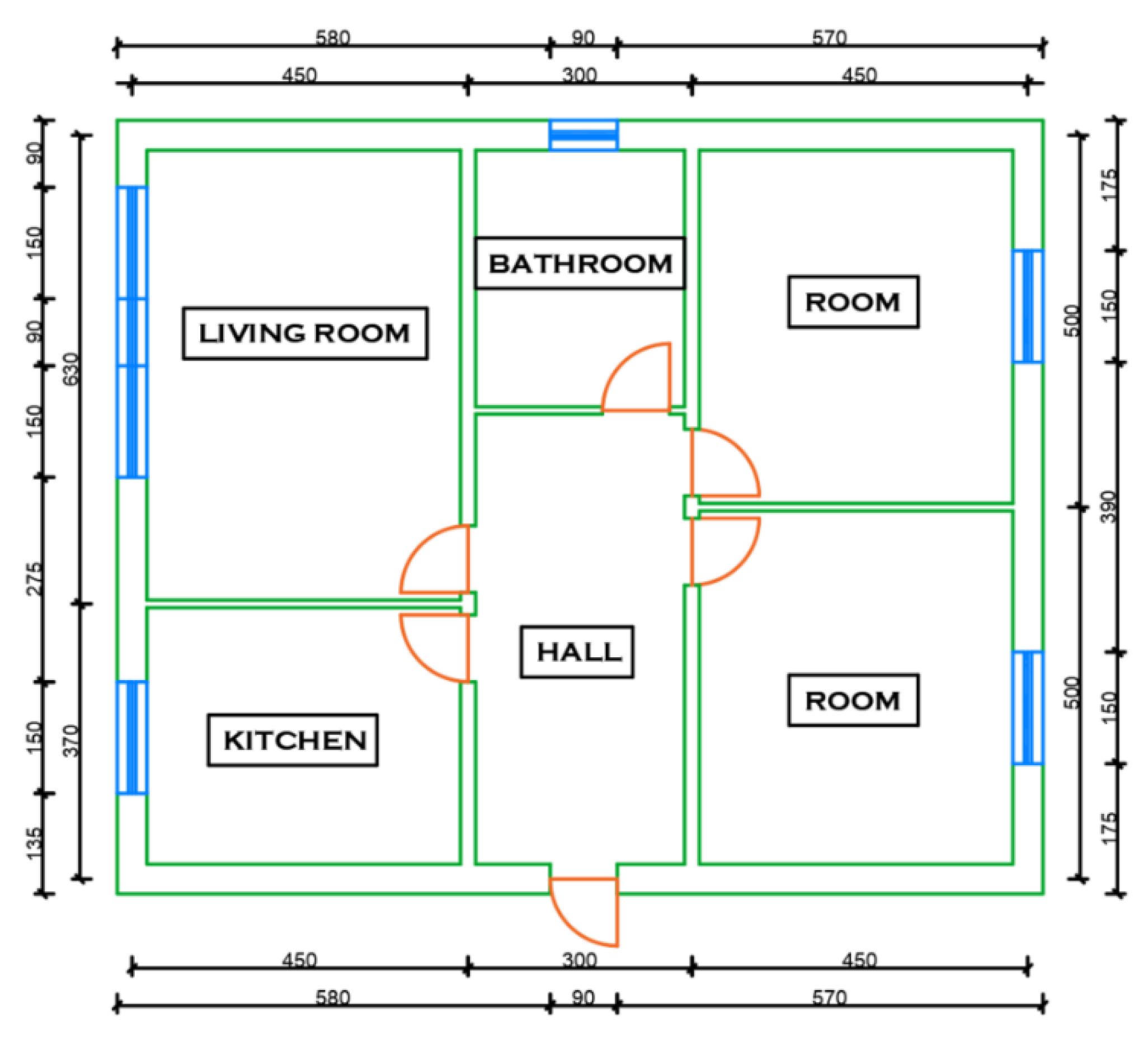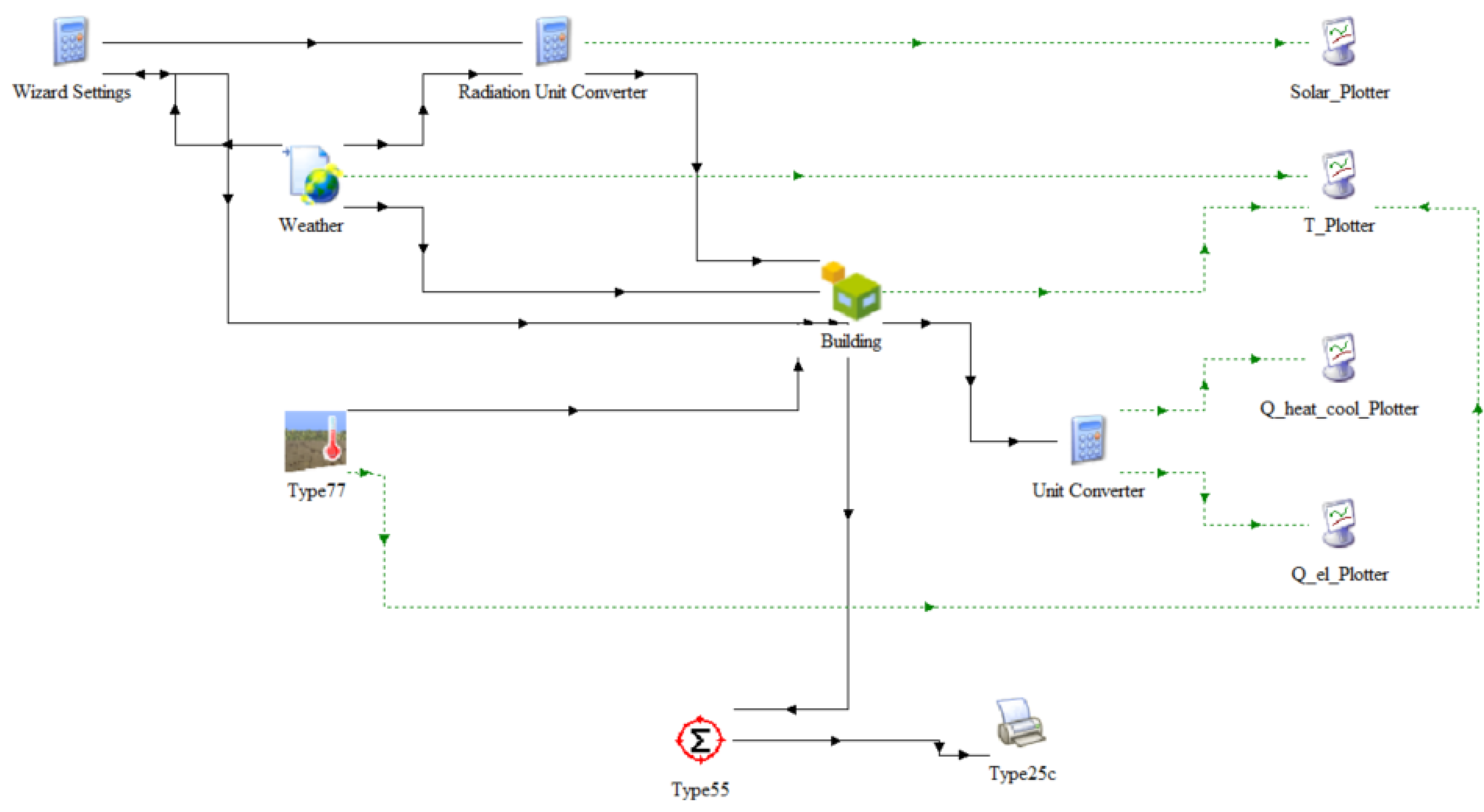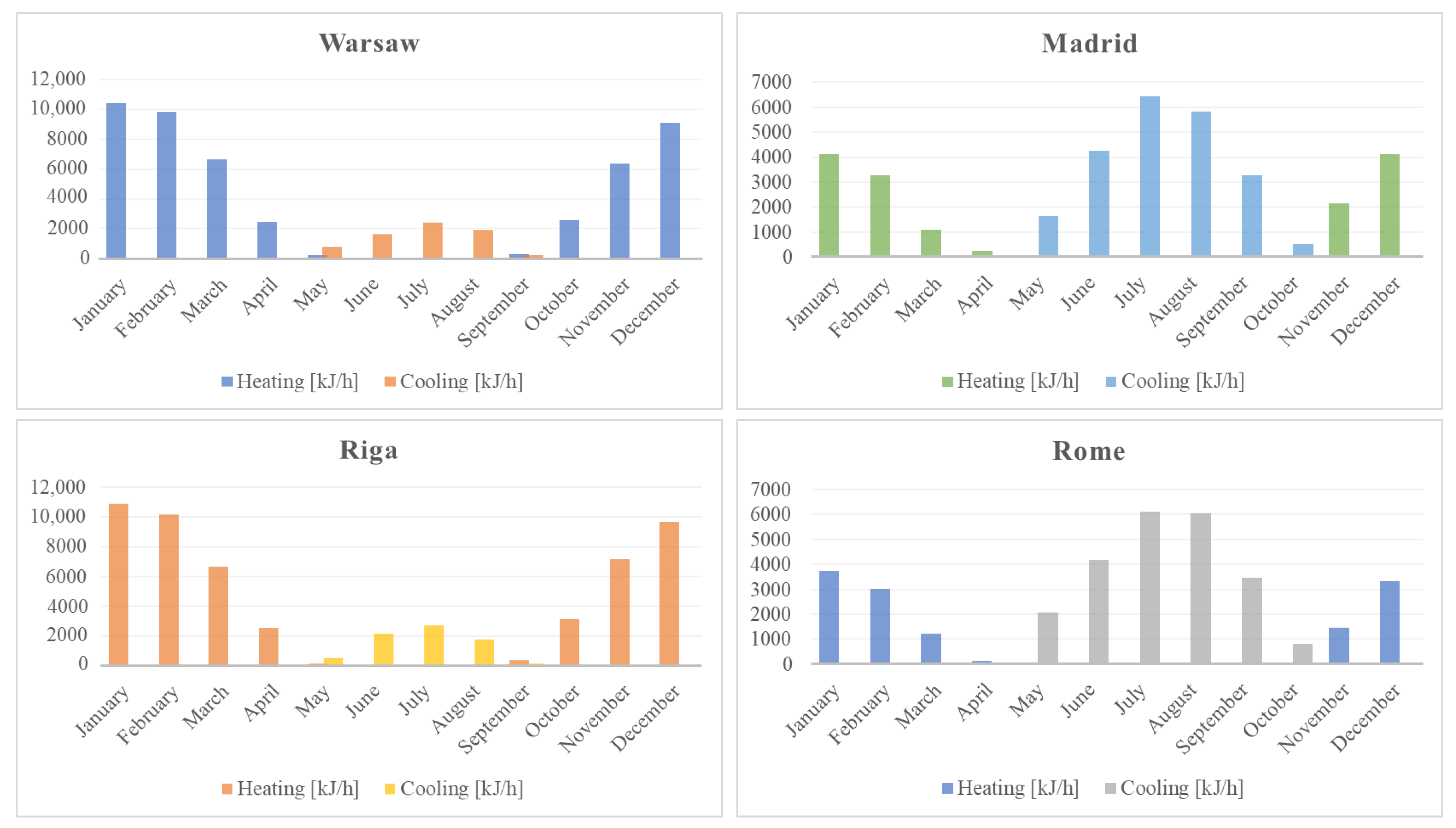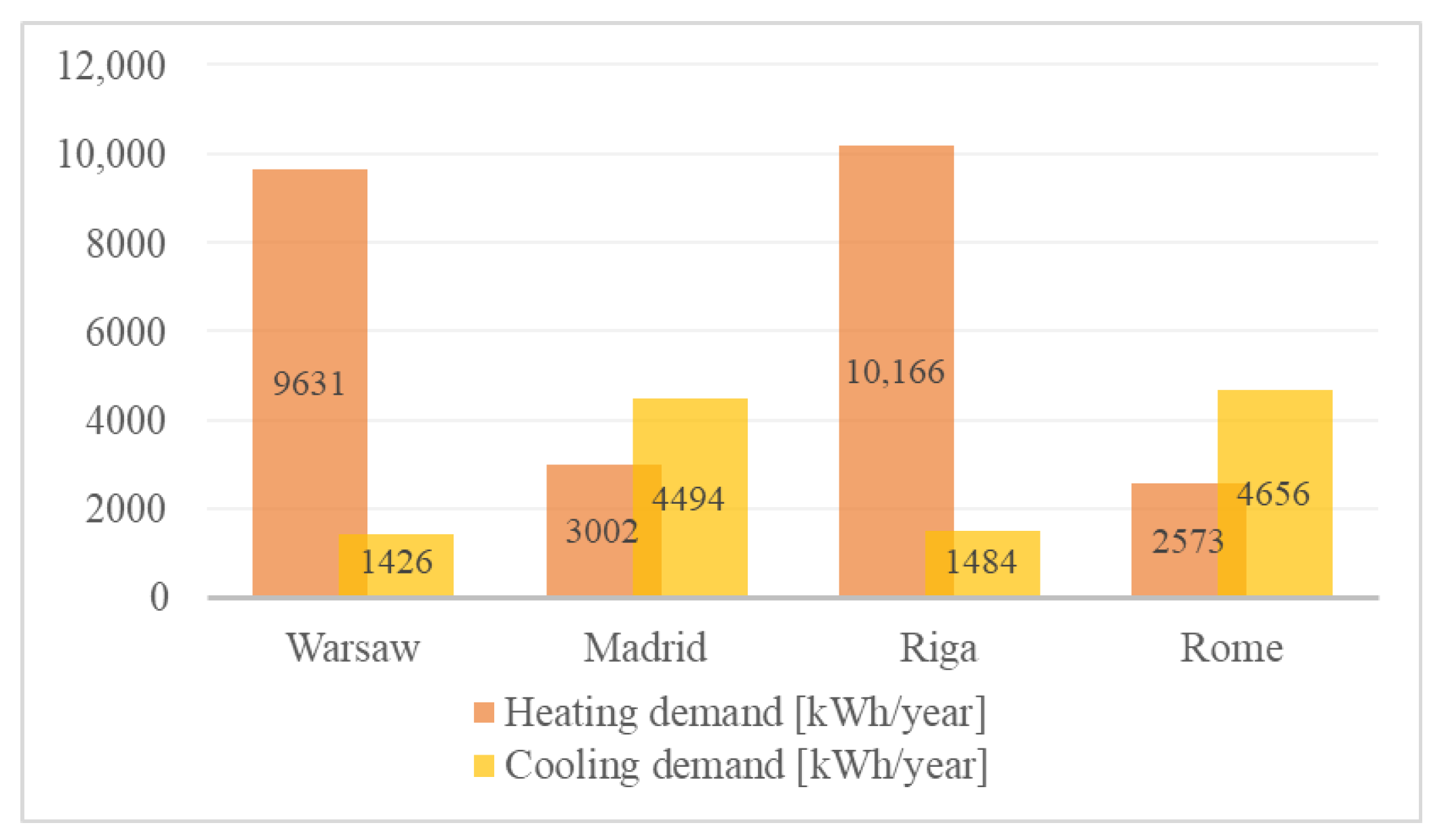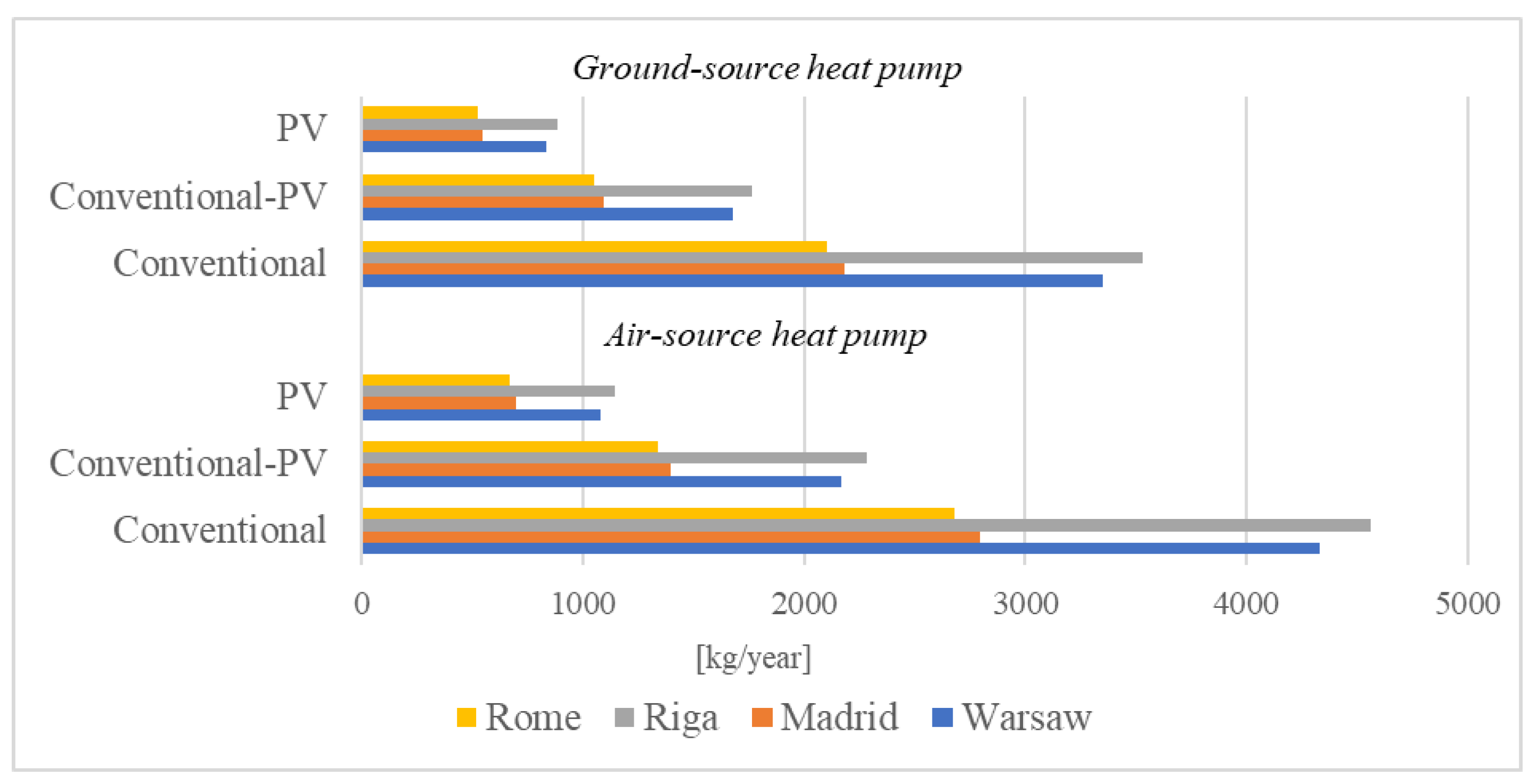1. Introduction
Following recent climate agreements, many European countries have taken ambitious goals to increase their share of clean energy in the national energy mix, thereby reducing global carbon footprint and greenhouse gas emissions, as well as curbing climate change [
1]. The EU goal is to achieve climate neutrality by 2050, that is, an economy with net zero greenhouse gas emissions [
2]. The transformation to a low-carbon energy future will require changes in transport, electricity, and heating fields, of which heating is the most carbon and energy intensive in the EU [
3]. Currently, various practical and reliable technologies for unconventional methods of cooling or heating have already been determined, but the sector is still being developed, especially in terms of increasing the efficiency of the systems [
4,
5,
6,
7]. Heat pumps are one of the most environmentally friendly technologies and can play a key role in a sustainable energy future. These devices work and look very similar to typical refrigerators, except that they provide both cooling in winter and heating in summer. They can transfer heat from natural resources in the human environment, such as air, ground, and water, as well as from sources like industrial or domestic waste [
1]. Current research is largely focused on hybrid systems that use heat pumps in combination with solar collectors (SC) or photovoltaic panels (PV) [
8,
9,
10,
11,
12,
13,
14], as well as on recovering waste heat and raising its temperature to more useful levels [
15,
16,
17,
18,
19]. Such solutions allow the increase of energy and economic efficiency of heating and cooling rooms, while bringing significant benefits to the environment. Wang et al. [
8] found that the combination of photovoltaic panels and an air source heat pump (PV-ASHP) runs to a coefficient of performance (COP) of around 3.75; however, with moderate cost and payback time, using a hybrid photovoltaic/thermal PV system joined with an ASHP (PV/T-ASHP), we were able to achieve a lower performance, with a mean COP of 2.90 and 3.03, respectively. Jeong et al. [
9] found that the initial investment cost of the hybrid system was higher than that of the existing ground source heat pump (GSHP) system but that the annual operating cost was reduced and payback time was estimated to be 7~11 years. Nouri et al. [
10] focused on the need for improvements in solar-assisted ground source heat pump systems (SAGSHPs) to match for higher efficiency and shorter payback time. Yang et al. [
11] noted that the performance of solar-assisted air source heat pumps (SAHPs) was affected by many factors, including system configuration, component size, working fluid, working conditions, and weather conditions. Fan et al. [
12] studied the development of SAHP and recommended future research focus on multi-source heat pump solutions using heat storage and exchange units (HSEU) or using waste heat and renewable energy to achieve higher COP. Sezen et al. [
13] concluded that parallel and dual-source indirect expansion, solar-assisted heat pumps (IDX-SAHPs) were preferable in high-solar irradiations of about 800 W/m
2 with their DSH mode options. Miglioli et al. [
14] claimed that a photovoltaic-thermal, solar-assisted heat pump (PVT-SAHP) system allowed for a high fraction of building thermal needs covered by renewable energy sources to be reached, as well as for an improvement in performance of both the photovoltaic-thermal collector and the heat pump. The possible applications of absorption heat pumps in waste heat reuse were studied by Xu and Wang [
15]. Tan et al. [
16] compared four types of heat pumps—the absorption heat pump (AHP), the absorption heat transformer (AHT), the steam jet pump (SJP), and the mechanical heat pump (MHP)—and found that when the heat ratio was higher than about 0.5, the MHP had the best energy performance. On the other hand, Ninikas et al. [
17] showed the outcome of a trial heating system using waste resources and the importance of a primary energy saving in Glasgow using a water source heat pump (WSHP). In another study [
18], Ninikas et al. discussed the benefits of an ASHP system for Glasgow. The performance of a typical air source heat pump could be increased significantly in relatively stable air temperature and humidity conditions [
19].
It is worth noting that the popularity of heat pumps is constantly growing, mainly due to their potential to reduce emissions, as well as the implementation of programs promoting “clean energy”. As a result, the transition to an ecologically conscious life is becoming easier and cheaper. Moreover, heat pumps are considered to be the most efficient alternative to oil, fuel, and electric systems, both in terms of heating and cooling and in domestic hot water preparation [
1]. These devices reduce the emission of carbon dioxide and other volatile pollutants into the atmosphere [
20,
21,
22] and have an efficient energy-to-heat conversion ratio, meaning that they provide more heating and cooling power than the amount of electricity used in their operation. It is important to note that the performance of heat pumps is strongly related to ambient conditions such as outdoor air temperature, which changes throughout the year, as well as type of installation and building characteristics [
3,
23]. The proper design and installation of these devices allows for an efficiency of over 300% [
24,
25]. Despite all the aspects mentioned above, the widespread adoption of heat pump technology faces several technological, economic, and political challenges [
1], the solving and understanding of which has become a popular direction for research among many scientists from around the world since the beginning of the 21st century.
Gaur et al. [
1] presented an extensive review of previous publications about heat pumps, with a special regard to their role in the decarbonization of the heating sector. In addition, recent technological advances in heat pump technology were analyzed. It was recognized that the potential of heat pumps to reduce emissions is greatly dependent on type of technology, location, and national energy mix.
Congedo et al. [
26] proposed the use of an air source heat pump system coupled with a horizontal earth-to-air heat exchanger in order to reduce energy consumption in buildings located in different climates. The operation of an ASHP-EAHX system was investigated using TRNSYS.
Sewastianik et al. [
27] compared indirect CO
2 emissions from different heat pump types installed in each Polish climate zone. They determined a seasonal coefficient of performance (SPF) for every location and estimated CO
2 emissions caused by electrical energy production. They found that ground and water source heat pumps met European Union requirements, which assume that only those heat pumps that are energetically viable may be applied (Seasonal Coefficient of Performance SCOP
net ≥ 3.5), while air source heat pumps would be energy and environmental viable only if significant changes were made to the Polish energy mix.
Valancius et al. [
28] provided a review of heat pump systems and applications within the European context, choosing Lithuania as a cold climate case study. They discussed future trends for heat pump technology development, cost and benefit predictions, and the environmental aspects of using heat pumps. They estimated that the SPF of heat pumps in the Baltic Region maintained a value between 1.8 and 5.6; the lower values were achieved by air source heat pumps, the higher by ground or water source heat pumps.
The higher efficiency of ground source heat pumps compared to air source has also been proven by Alshehri et al. [
29], who showed that the average annual COP (coefficient of performance) and EER (energy efficiency ratio) for ground source heat pumps were 4.1 and 15.5, respectively, while for air source heat pumps, they were 3.8 and 11.
Rivoire et al. [
30] assessed the energetic, economic, and environmental effectiveness of ground-coupled heat pumps for three building types (residential, office, and hotel), with two variants of building envelope insulation levels (good or poor), in the climatic conditions of six European cities. They stated that, in Italy, ground source heat pumps can reduce carbon dioxide emissions up to 216 g/year per euro spent, but payback time remains fairly high—from 8 to 20 years.
Witkowska and Krawczyk [
31] analyzed the advisability of using a heat pump for heating and cooling a single-family building in Wroclaw and in Cordoba. Based on the results of heat loss and gain, they estimated the demand for heating and cooling and selected heat pumps. In addition, they determined the investment and operating costs of the system and concluded that the total cost of using air heat pumps was almost 44% lower for Cordoba than for Wroclaw.
Kachalouski and Tomáš [
32] analyzed the operations of air source and ground source heat pumps used in domestic hot water preparation. They found that the system seasonal performance factor (SPF) of air source heat pumps for medium latitudes in Europe reached a value of 3.0. The results of ground source heat pump performance were similar to those obtained for air source heat pump performance.
Jadwiszczak et al. [
30] investigated which factors (national energy mix, heat pump technology, or changing climate) had the highest impact on heat pump emissions. They revealed that when using an air-to-water heat pump for heating, cooling, and domestic hot water purposes, CO
2 emissions depend on the national energy mix (55.2%), the heat pump technology (33.9%) and changing climate (10.9%).
Roy et al. [
33] investigated the feasibility and efficiency of a vertical ground source heat pump system in heating and cooling a typical office building located in 10 cities with tropical and subtropical climates. They estimated that a GSHP could be economically viable and efficient in cities with subtropical climates, where there is a greater balance between heating and cooling loads.
Various new studies focusing on the identification of an optimal heat source, in particular a renewable one like the heat pump, are currently being conducted. To find a solution, it will be necessary to take into account differences in climate, as well as legal and financial policies. This paper focuses on the results of energy simulations for a single-family building, located in four different European countries, in which air and ground heat pumps were considered an energy source for heating, ventilation, and air conditioning (HVAC) systems. Moreover, we conducted an economic analysis, including investment and operating costs, as well as an ecological estimation, of carbon dioxide emissions. The purpose of the simulation was to estimate in which climate zones the use of heat pumps is most beneficial and to conduct an energy, economic, and environmental analysis showing the difference in results for cities located in similar as well as in different climatic conditions.
2. Materials and Methods
The analysis was performed for a single-family residential building consisting of only a ground floor. The object has three rooms, a bathroom, kitchen, and hall. It is characterized by a simple construction and intended for the living of 4 people. The volume of the building is 360.0 m
3, while the usable area is 120.0 m
2. The construction materials meet all applicable technical requirements. The plan of the analyzed object is presented in
Figure 1, while the model is shown in
Figure 2.
The building model was created in SketchUp, implemented to the TRNBuild, and then modified. For the purposes of the analysis, the heat transfer coefficients “U” of the building envelope, as well as their thickness, were assumed for buildings with reduced energy demand. The main data is presented in the table below (
Table 1).
Simulations of the building model presented below were created in Simulation Studio and then modified in TRNBuild, both of which are included in the TRNSYS software (
Figure 3). The duration of the simulation was assumed as 1 year (8760 h) divided into 12 months, and the simulation time steps was set as 1 h. The aim of the simulation was to determine heating and cooling loads in the analyzed locations.
To determine energy gains due to lights, equipment, and people, an occupancy schedule was implemented, which provided that from Monday to Friday (on working days) the building was used primarily from 00:00 a.m. to 07:00 a.m. and from 04:00 p.m. to midnight. The indoor temperature was adapted to meet thermal comfort conditions. In the case of heating, it was set as 20 °C, while in the case of cooling, it was set at 24 °C. It was also assumed that the amount of air exchanged due to infiltration depended on wind speed. The capacity of the heat pumps was estimated based on the maximum values of the heating and cooling loads. Investment expenditures for the purchase and installation of heat pumps were determined using a company’s price list [
34], while the operating costs were estimated on the basis of energy prices in each country [
35], as well as coefficients of performance (COP), energy efficiency ratios (EER) of the selected air and ground source heat pumps, and the energy demand for heating and cooling the building. The total energy prices included energy, network, taxes, and VAT and were, respectively, EUR 0.18 in Poland, EUR 0.22 for Spain, EUR 0.16, and EUR 0.22 for Italy. An ecological estimation of carbon dioxide (CO
2) emissions was conducted using Audytor EKO 1.0 software.
3. Results and Discussion
Analyzing the results of extreme heating and cooling loads during the year, as presented in
Table 2, it can be observed that the maximum instantaneous value of the heating load was obtained in Riga in February, and it was 27,548.1 kJ/h (7.65 kW), while the maximum value of the cooling load was obtained in Madrid in July, and it was 14,618.4 kJ/h (4.06 kW). Differences in heating loads between towns located in the northern and southern parts of Europe were significantly higher than the margins in cooling loads.
In order to cover the heating and cooling needs of the buildings located in different climatic zones, air-to-water and ground-to-water heat pumps were selected. Maximum values of heating and cooling loads for different cities were used to select the capacity of the devices. The following table (
Table 3) shows the most relevant data of the selected heat pumps.
After analyzing the data presented in the
Table 3, it can be seen that the highest investment costs were achieved in Warsaw and Riga, using ground source heat pumps, while the lowest were in Madrid and Rome with the implementation of air source heat pumps. The difference between the cheapest and the most expensive possibility was almost 40%.
Figure 4 shows the results of the mean heating and cooling loads in different months. It can be deduced that in Warsaw and Riga, which are characterized by similar climate conditions, cooling is necessary from June to August, while heating is necessary from January to April and from October to December. The situation is similar between Madrid and Rome. The highest need for cooling occurs in these cities from May to September and for heating occurs from January to March and from November to December.
After summarizing heating and cooling loads in different months, energy demand was calculated (
Figure 5).
The results show that similar heating and cooling demand occurs between Warsaw and Riga and between Madrid and Rome. The highest value of heating demand was achieved in Riga, while the lowest was recorded in Rome. The difference was 75%. The highest value of cooling demand was obtained in Rome, while the lowest was in Warsaw. In this case, the difference was 69%. The highest total energy demand was achieved in Riga, and it was 38% more than in Rome, where the demand was the lowest.
An estimation of the operating costs of selected air and ground source heat pumps in analyzed cities are summarized in
Table 4.
After analyzing the results, it can be seen that the lowest operating cost was achieved in the case of ground source heat pump use in Rome, while the highest was in the case of air source heat pump use in Warsaw. The highest cost of heating occurred in the building located in Warsaw and heated by an air source heat pump, while the lowest occurred if the building was located in Rome and heated by a ground source heat pump. On the other hand, the highest cost of cooling was in the case of the building located in Rome and cooled by an air source heat pump, while the lowest would be if the building was located in Riga and cooled using a ground source heat pump. Our findings are consistent with results obtained by Smitt et al. [
36]. Their analysis for different European locations showed that payback periods for integrated CO
2 heat pump systems for heating, cooling, and hot water production in hotels were lower in Mediterranean climates than in Scandinavian towns.
A comparison of the total CO
2 emissions between the analyzed cities, divided by air source or ground source heat pump, is shown in the figure below (
Figure 6). Though the structure of energy production varies by country, regardless of location, the following three alternatives were considered for analysis:
Conventional: 100% production from conventional sources;
Conventional-PV: 50% production from conventional sources and 50% from photovoltaic panels;
PV: 75% production form photovoltaic panels and 25% production from conventional sources.
Estimated CO
2 emissions for a typical year, taking into account energy production for each source of energy and location, are considered in the paper. It can be seen that for each variant, the highest values of CO
2 emission were achieved in Riga, while the lowest were in Rome. Additionally, in all cases, CO
2 emissions are higher with the usage of air source heat pumps. As the production of energy-using photovoltaic panels is characterized by zero emissions of carbon dioxide, their use (depending on the adopted variant) allows for the reduction of the total emission of CO
2 by 50 or 75%. From an ecological point of view, ground source heat pumps supplied by energy generated in PV plants should be prioritized. For instance, in the case of Poland, where the share of renewable resources for energy production is extremely low, the application of the “Conventional-PV” variant would allow for the annual reduction of CO
2 from about 4330 kg to about 2165 kg, while the “PV” alternative could go as low as 1080 kg. In addition, recently, the share of electrical energy from PV systems has increased significantly. According to a report [
37] from the end of 2020, Poland placed first in the European Union and 13th globally in terms of growth rate of photovoltaic power. As shown in a recent report [
38], in 2020, a significant increase was noted in the Netherlands, Spain, Poland, France, and Italy, whereas in other countries it was several times lower. Another report estimated the cumulative growth rate in 2016–2020 at 114% and that of the EU at 10.3% [
37]. On the other hand, the total cumulative installed capacity in the EU at the end of 2020 amounted to 151,2 GW; although a large part of it is connected with systems in Italy (21,7 GW) and Spain (12,7 GW), in Latvia and Poland this type of energy generation is still low [
38]. Thus, reduction of CO
2 emission depends not only on building location, energy consumption, and type of heat pump to be used, but also national fuel policy and accessibility and resources.
4. Conclusions
Analyzing the results, it can be observed that in terms of energy needs, the lowest value is characterized by the building located in Rome, in which total energy demand, including both heating and cooling, was estimated at about 60 kWh/m
2year. In terms of economic and environmental aspects, the use of heat pumps is also the most advantageous when considering Rome, as both the cost of purchasing and installing the heat pump, as well as operating costs and total CO
2 emissions, reached the lowest values there. Second place was taken by Madrid, for which the values discussed above were only slightly higher. On the other hand, the implementation of heat pump systems was the least beneficial in Warsaw and Riga, which had the highest energy demand (more than 90 kWh/m
2year), as well as a higher cost of purchasing and operating the heat pump and higher total carbon dioxide emissions. It is worth mentioning that, according to Dobkowska [
39], the structure of energy production in Italy (Rome) and Latvia (Riga) is close to the “PV” variant, which produces comparatively low CO
2 emissions. In Spain (Madrid), the RES share reaches 55%, which indicates a similarity to the “Conventional-PV” alternative. Only in Poland (Warsaw) is the share of RES and biofuels low—at the level of about 16%, which is a rationale for setting more ambitious energy goals. All the results show that climatic conditions are very important when considering the advisability of using heat pumps in single-family buildings, which was also analyzed in [
3,
23,
28,
30,
33]. Heat pumps for HVAC purposes seem to be of greater benefit in Mediterranean-type subtropical climates (Madrid and Rome), where winters are mild and summers are hot, than for continental-type climates (Warsaw and Riga), where there are long and cold winters and short and mild summers. This is consistent with findings of Rivoire et al. [
31].
Research on heat pumps as a low-carbon, high-efficiency energy source contributes to Sustainable Development Goals 7 and 13 on Affordable and Clean Energy, which involve increasing the share of renewables in the global energy mix, doubling the global rate of improvement in energy efficiency, and upgrading and expanding technologies to provide clean and more efficient energy in all countries, while fostering economic development [
40]. In practice, this means investing in renewable energy sources such as solar, air, and ground energy. Both ground and air source heat pumps are undoubtedly examples of the most sustainable methods of energy generation. The widespread availability of heat pumps makes their potential continue to grow. Increasing the share of renewable energy sources such as heat pumps in the national energy mix will help stop the devastation of the environment by providing a source for the more reasonable and efficient generation of energy, as well as reduce emissions of carbon dioxide and volatile pollutants into the atmosphere. This in turn fits perfectly with the idea of Sustainable Development Goal 13 on Climate Action. The contribution of renewable energy sources to meeting sustainability goals has also been analyzed [
41].
This paper provides information regarding the distribution of heating and cooling demand by month for four cities with different climatic conditions. It can be a starting point for further research focusing on increasing the energy and economic efficiency of heat pumps, especially in cold climates. The results show that increasing the share of renewable energy sources (RES) in the national structure of energy production contributes to the reduction of CO2 emissions and the fulfilment of Sustainable Development Goals, both important issues in light of recent European Union requirements.
